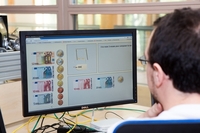Flowers Laboratory
FLOWing Epigenetic Robots and Systems
The Kidlearn Project
The Kidlearn Project
 Kidlearn is a research project studying how machine learning can be applied to intelligent tutoring systems. It aims at developing methodologies and software which adaptively personalize sequences of learning activities to the particularities of each individual student. Our systems aim at proposing to the student the right activity at the right time, maximizing concurrently his learning progress and its motivation. In addition to contributing to the efficiency of learning and motivation, the approach is also made to reduce the time needed to design ITS systems.
Kidlearn is a research project studying how machine learning can be applied to intelligent tutoring systems. It aims at developing methodologies and software which adaptively personalize sequences of learning activities to the particularities of each individual student. Our systems aim at proposing to the student the right activity at the right time, maximizing concurrently his learning progress and its motivation. In addition to contributing to the efficiency of learning and motivation, the approach is also made to reduce the time needed to design ITS systems.
Intelligent Tutoring System (ITS) are computer environments designed to guide students in their learning. Through the proposal of different activities, it provides teaching experience, guidance and feedback to improve learning.
The FLOWERS team has developed several computational models of artificial curiosity and intrinsic motivation based on research on psychology that might have a great impact for ITS. Results showed that activities with intermediate levels of complexity, neither too easy nor too difficult but just a little more difficult that the current level, provide better teaching experiences.
The system is based on the combination of three approaches. First, it leverages Flowers team’s recent models of computational models of artificial curiosity and intrinsic motivation based on research in psychology and neuroscience. Two overviews can be be found in (Gottlieb et al., 2013; Lopes and Oudeyer, 2012).
Second, it uses state-of-the-art Multi-Arm Bandit (MAB) techniques to efficiently manage the exploration/exploitation challenge of this optimization process.
Third, it leverages expert knowledge to constrain and bootstrap initial exploration of the MAB, while requiring only coarse guidance information of the expert and allowing the system to deal with didactic gaps in its knowledge.
Expected benefits
We expect that this research will contribute to improve intelligent tutoring systems in several ways:
- Filling didactic “holes” : reduce the problems due to badly specified teaching sequences and restrictions between activities
- Compensation of didactic weaknesses that create blockages and incorrect paths.
- Optimizing the didactic sequences by identifying activities that permit to progress the most, without compromising success
- Conception time saving : limit the number of differentiated sequences to define.
- Motivation optimization : propose to the learner the likely activity to progress and motivate the most.
References
Multi-Armed Bandits for Intelligent Tutoring Systems
Benjamin Clement, Didier Roy and Pierre-Yves Oudeyer, Manuel Lopes
Journal of Educational Data Mining (JEDM), 2015 (arXiv:1310.3174 [cs.AI])
Online Optimization of Teaching Sequences with Multi-Armed Bandits
Benjamin Clement, Didier Roy, Pierre-Yves Oudeyer and Manuel Lopes (2014)
The 7th International Conference on Educational Data Mining (EDM), London, England.
Information Seeking, Curiosity and Attention: Computational and Neural Mechanisms
Gottlieb, J., Oudeyer, P-Y., Lopes, M., Baranes, A. (2013)
Trends in Cognitive Science. http://dx.doi.org/10.1016/j.tics.2013.09.001 Bibtex
The Strategic Student Approach for Life-Long Exploration and Learning
Lopes M., Oudeyer P-Y. (2012)
in Proceedings of IEEE International Conference on Development and Learning and Epigenetic Robotics (ICDL-Epirob), San Diego, USA. Bibtex
Intrinsic Motivation Systems for Autonomous Mental Development
Oudeyer P-Y, Kaplan , F. and Hafner, V. (2007)
IEEE Transactions on Evolutionary Computation, 11(2), pp. 265–286. Bibtex
Software



